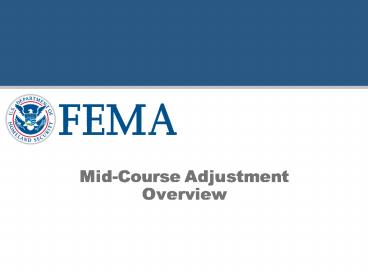MidCourse Adjustment Overview - PowerPoint PPT Presentation
1 / 25
Title: MidCourse Adjustment Overview
1
Mid-Course AdjustmentOverview
2
The Question
- The committee understands that the 5-year,
1,000,000,000 program will not update all flood
maps some maps will merely be converted to a
digital format. The Committee is concerned that
this program was originally portrayed as a means
to update all of the Nations flood maps.
Because this is not the case, the Committee
directs EPR to provide a report, no later than
January 16, 2006, on the percentage of maps that
will be updated, not merely transferred to a
digital format, and the percentage of population
that the updated maps cover.
3
2006 Congressional Report
- Delivered to Congress February 2006
- Describes the Status of Map Modernization as of
Sept 30, 2005 - Describes Mid-Course Adjustment
4
2006 Mid-Course Adjustment Report
- Detailed description of Mid-Course Adjustment
Report - Provides supporting documentation for the
Congressional report
5
Background
- Rationale for Review and Adjustment
- Midpoint review appropriate on large initiative
- Introduction of floodplain boundary standard
- Stakeholder request for additional engineering
6
Background
- Rationale for Review and Adjustment
- Lessons learned from State business plans and
recent disasters - Updates will occur on a sub-county basis
prioritized by risk - The goal of mapping the Nation remains, but is
delayed
7
New Metrics
8
Benefits
- Provide more detail in high risk flood prone
areas - Action is responsive to
- Congress (quality vs. quantity)
- Stated Map Coalition positions
- Needs as identified through State business
planning process
9
Potential Implications
- 90 of census block groups at risk would receive
digital flood boundaries - Low risk areas may not receive digital flood
boundaries - This delays achieving the goal of creating a
nationwide digital flood layer and requires
additional resources beyond NFIP fees after 2008 - Requires combining new digital data with existing
products - Requires re-sequencing of projects
- Validation becomes the process to document what
needs a new study e.g., scoping tool, become
data justifying funding beyond 2008
10
Current Risk / Funding Calculations For FY05
- Ten County-based variables
- Population
- Housing Units
- All claims
- Rep Loss Claims
- Rep Loss Properties
- Policies
- Total 100K NHD length
- Predicted population growth to 2015
- Cost limiting factor
- Flood disasters
11
Refinement of Analysis
- 210,808 Block groups were analyzed
- Higher geographic resolution than counties and
census tracts while more manageable than blocks - Allows the separation of very low risk areas
within a county from higher risk areas
12
Risk Parameters for Block Groups
8 Parameters for Block Group Risk
- Population density (Census block group data)
- Housing unit density (Census block group data)
- Claims density (From FIA Claims dataset)
- Repetitive losses claims density (From FIA Claims
dataset) - Repetitive loss properties density (From FIA
Claims dataset) - Policies density (From county distribution)
- Disasters (From county distribution)
- Population Growth from 1990-2000
13
Area and Population Targets
14
FBMS and Validation Targets
15
Lowest 10 Risk Areas
16
330 Counties with all Block Groups of 90100
Risk
17
Implementation of Mid-Course Adjustment
National Tasks
- National Tasks
- Policy Papers (What to do with Decile 10 areas,
If FY03-FY05 boundaries change, when is a new
appeals period needed ) - Validation
- Blending areas within Decile 10
- Appeals Notice If boundary changes but no BFE
or BFE stays the same - Many Others .
- Standards / procedures for tracking progress
- Potential tool enhancement
- Modification of the Spring / Summer 2006
Multi-Year Flood Hazard Identification Plan
(MHIP) - National Communications Plan
18
End State National Goals
- Continental area of the Country with digital maps
- Population of the Nation
- Miles of study in FEMAs Inventory
- Miles that conform to FPBS
- Miles that are new / updated / validated
19
MHIP How is the flood map update sequencing
determined?
- High-Level Sequencing Process
HQ Provides Funding Distribution, Other Guidance
to Regions
HQ Reviews Sequencing Changes
Regions Update Sequencing
Finalize MHIP
20
How is the flood map update sequencing determined?
- Regional process
- Review prior sequencing
- Review State business plans and other input
- Review comments on Region-specific sequencing
- Update sequencing for Region
21
FY05-FY09 MHIP (V 1.5) Scope
- MHIP includes revised actual completions and
projections for Map Mod Key Performance
Indicators reflecting updated flood map update
sequencing from State/Regional business planning
efforts - The MHIP supports FEMAs performance goal
Improve safety of the Nations population through
availability of accurate flood risk data in GIS
format
22
Upcoming Release on FEMA Web Site Planned
www.fema.gov/plan/prevent/fhm/mh_main.shtm
23
Mid-Course Adjustment Summary
- Regions appear to have adequate funds to allow
for implementation - Changes are likely required for FY06
- Re-work for 03-05 studies likely
- The goal of mapping the Nation remains, but is
delayed
24
Mapping Status Tools
- Letter of Final Determination list
- Appendix A of the MHIP v2.0
25
(No Transcript)































